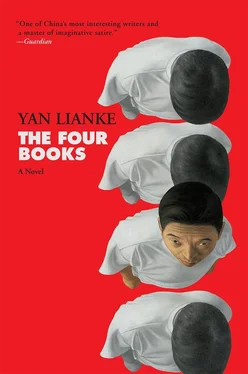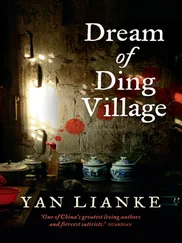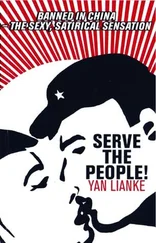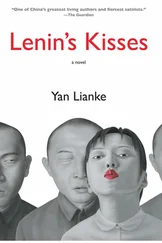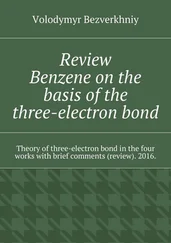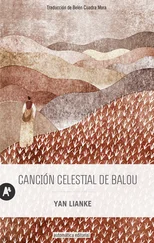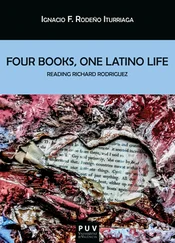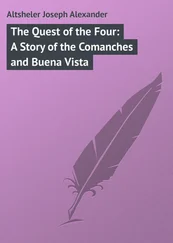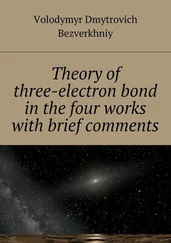Everyone carried the books to the Child’s house.
Each time they brought a stack, the Child would select one of the volumes and hold it up, then he would clear his throat and ask, “Whose was this? Tell me, if our ninety-ninth were to produce six hundred jin per mu , would that count as a lot?”
He lifted another, and said, “Our production target of six hundred jin —is that a lot?”
He lifted yet another, and said, “Are you willing to go work the fields?”
He lifted a cloth-bound volume, and said, “This book is unimaginably reactionary. Tell me, can a mu of land produce six hundred jin of grain?”
By midday, the Child had examined every book in the pile, and finished asking his questions. At that point the people took their plows and drills, and went out to plow the fields.
CHAPTER 2. Re-Ed District
1. Old Course , pp. 1–2
I started to write, like a boat floating down a river.
I had pen, paper, and ink. My manuscript was titled Criminal Records by the higher-ups, who asked me to record every detail pertaining to the criminals residing in the ninety-ninth. I dreamed that one day I might write another book, but it would be a very different kind of book. The instant I accepted the pen, ink, and paper that the Child gave me, my hands began to tremble. I was already over fifty years old, and in addition to five novels, more than twenty novellas, and several hundred short stories, I had also published several essay collections. My fiction had been translated into English, Russian, German, French, and Italian, as well as Korean and Vietnamese. Movies adapted from my novels had become household names, and won prizes at international film festivals. Before the nation’s higher-ups went abroad, they would often ask me to sign copies of my most famous novels, which they would then use as gifts when meeting with foreign presidents and heads of state. And precisely because I enjoyed such acclaim, when our writers’ work unit failed to meet its production quota, I convened a meeting of all the prominent authors and critics in the entire province. The meeting began at eight in the morning, and by noon it still showed no signs of concluding. The task of picking a reactionary figure to send to Re-Ed was even more difficult than electing a president in some countries. After three straight days of voting, the authors and critics were as frustrated as a torrential downpour. On the third day, it was already an hour past the time to break for lunch, and everyone was famished, their lips parched and their mouths dry. At this point, they finally called on me and said, “You are a prominent author and the director of the Writers’ Association, so whomever you designate as a reactionary must be one. Say a name, and we’ll all raise our hands in agreement.”
I was keenly aware that we were in a state of political turmoil, and naturally couldn’t name just anyone.
Instead, I gave everyone a sheet of paper and proposed that we have an anonymous ballot. I had everyone write the name of whomever they regarded as a reactionary figure. I even diplomatically suggested, “If you’re afraid that your handwriting might be recognized, you can simply imitate someone else’s, write with your left hand, or even write with your eyes closed. In any event, using unrecognizable handwriting, please write down the name of whomever you believe to be a reactionary and pass it to me.”
Everyone used this uniquely democratic method and wrote down a name, and the person whose name appeared most often would be selected. In the end, however, it turned out that it was my own name that appeared on virtually every ballot.
I was selected in a landslide.
As a result, I wrote a certain political leader a letter, detailing my publications, my artistic accomplishments, and my loyalty to the nation. I hoped that the authorities in the capital would be able to intervene and remove my name from the list. The higher-ups immediately wrote me a response, saying, “Your literary accomplishments are very impressive, making you perfectly suited to go to Re-Ed to write a real revolutionary book.”
The day I left the provincial seat, all of the work unit comrades who had voted for me came to see me off. They all said, You are the only one among us who can use your accomplishments, reputation, and public acclaim to resist the reformers. After you leave we will help look after your family, your children, and your friends.
2. Old Course , pp. 7–10
The ninety-ninth was located in the central plains region about forty kilometers south of the Yellow River. This stretch of terrain was full of silt that the Yellow River had left behind after repeatedly changing course. Because the Yellow River had flooded over the course of millennia, the quality of the soil was very poor. Most of the peasants had already moved away, leaving only sand, wild grass, and an endless expanse of wasteland interspersed with a handful of villages. This was a perfect place to build prisons to house criminals. From the Ming dynasty to the post-Liberation period, prisons had flourished here. The number of prisoners peaked at more than thirty-five thousand, including those sentenced to death as well as others sentenced to labor reform. The primary labor involved reinforcing the embankments along the Yellow River — dredging mud out of the old riverbed, then taking the upper layer of yellow silt and burying it beneath the mud. In this way, it was possible to transform barren wasteland into fertile soil. Reclaiming these thousands of mu of sandy terrain was the work of political criminals engaging in labor reform, planting grain and cotton. Several years after the founding of the People’s Republic, this ceased to be a labor reform colony, and instead became a Re-Ed region.
Re-Ed retained the same architecture and distribution networks from when it had served as a prison, but now it had a new headquarters and subdivisions. The headquarters was located in town, and it was surrounded by housing areas and fields, which ranged in size from several thousand mu to nearly ten thousand. No one knew for sure precisely how many criminals and how much land belonged to this Re-Ed region. Some claimed there were more than 18,700 criminals in Re-Ed, while others claimed there were more than 23,300. In any event, of these approximately 20,000 criminals, 90 percent were professors, scholars, teachers, writers, and intellectuals from a variety of different fields. The remaining 10 percent were national cadres and high officials. In our ninety-ninth alone, there were 127 criminals, of whom 95 percent were intellectuals.
The ninety-ninth was located farthest from the headquarters and closest to the Yellow River, and consequently there was no need to fear that anyone would flee. If someone were to proceed to the left, right, or straight ahead, for the first ten or twenty li they would be hard-pressed to find anyone other than other groups of criminals undergoing Re-Ed. Finally emerging from the wilderness, they would see plowed fields and might assume that they’d made it back to society, though in reality these would actually be farms cultivated by criminals from other Re-Ed districts. These would be criminals in need of re-education. According to Re-Ed regulations, criminals who report one of their own with the intent to flee will be rewarded with a monthlong visit home, and if they apprehend a criminal in the process of escaping, they will be rewarded with a three-month visit home. If they catch three criminals attempting to flee, they will earn the right to return permanently to their hometown and their original work unit. In Re-Ed, everyone is waiting for an opportunity to report someone or catch someone trying to escape. Of course, those attempting to flee could always head north, crossing the Yellow River and proceeding to the villages on the other shore. However, the middle portion of the river, after it has passed Gansu and flowed through Shaanxi toward Henan, always floods during the rainy season, stirring up vast amounts of sand and silt, and consequently no one has ever dared try to ford it. In winter, the water along the banks of the river freezes solid, and people can walk over it, but in the center, in areas where it is dozens of meters wide, the bone-chillingly cold water flows too fast to freeze, making it impossible to cross. The Yellow River constitutes a natural barrier for Re-Ed, like a no-man’s-land along a nation’s border. Those of us in the ninety-ninth are surrounded by the river. Some people have tried to flee, but they were all caught by others and brought back, and while their punishment was redoubled, those who caught them were deemed to be re-educated and permitted to return home. Some people thought that the Yellow River was lower in late autumn and early winter, but when they tried to cross they drowned before getting very far, and their corpses appeared on the riverbank about twenty li downstream. There was one person who did succeed in escaping, but after he returned home, his wife and children, acting out of either fear or a new awareness, brought him back to Re-Ed. As a result, he ended up being transferred from Re-Ed to prison, while his wife was promoted from an ordinary schoolteacher to a school principal, and from section chief to department head.
Читать дальше
